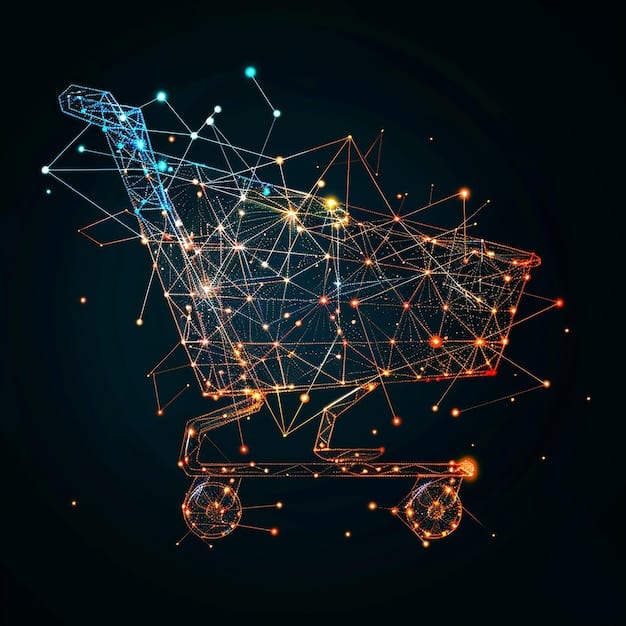E-commerce Platform Updates: Essential 2025 Changes to Stay Ahead

E-commerce Platform Updates: Stay Ahead of the Curve with These 3 Essential 2025 Changes focuses on personalization, AI driven experiences, and Headless Commerce architecture. Adapting to these changes will be crucial for businesses aiming to thrive in the evolving e-commerce landscape.
In the fast-paced world of e-commerce, staying ahead requires constant adaptation. As we look towards 2025, several key platform updates are set to redefine the online shopping experience. It’s essential to understand these potential shifts to ensure your business isn’t left behind. What are the most impactful changes on the horizon? This article explores **E-commerce Platform Updates: Stay Ahead of the Curve with These 3 Essential 2025 Changes**.
From enhanced personalization to the integration of advanced AI, the future of e-commerce platforms promises a more seamless and intelligent shopping journey. By understanding and preparing for these changes now, you can strategically position your business for success in the years to come.
E-commerce Platform Updates: Navigating the Future Landscape
The e-commerce landscape is constantly evolving, driven by technological advancements and changing consumer expectations. To remain competitive, businesses need to be aware of emerging trends and adapt their strategies accordingly. Let’s explore some key areas that will shape the future of e-commerce platforms.
Personalization Takes Center Stage
Personalization is no longer a luxury; it’s an expectation. Consumers want tailored experiences that cater to their individual needs and preferences. Businesses that can deliver personalized recommendations, targeted promotions, and customized content will have a significant advantage.
AI-Driven Shopping Experiences
Artificial intelligence is revolutionizing the way people shop online. AI-powered chatbots provide instant customer support, while machine learning algorithms analyze user data to optimize product recommendations and personalize search results. The possibilities are endless.
- AI-powered product recommendations
- Personalized search results
- Automated customer service chatbots
- Dynamic pricing optimization
In conclusion, personalization and AI are becoming increasingly intertwined, creating more engaging and effective shopping experiences. Businesses that embrace these technologies will be well-positioned to succeed in the future.
The Rise of Headless Commerce
Headless commerce is an architectural approach that separates the front-end presentation layer (the “head”) from the back-end e-commerce engine. This separation allows for greater flexibility and customization, enabling businesses to deliver seamless experiences across multiple touchpoints. What is behind **E-commerce Platform Updates: Stay Ahead of the Curve with These 3 Essential 2025 Changes**? Let’s dive in.
Understanding the Headless Architecture
In a traditional e-commerce platform, the front-end and back-end are tightly coupled. Headless commerce decouples these components, allowing developers to build custom front-end experiences using different technologies and frameworks. This flexibility is essential for businesses that want to differentiate themselves from competitors.
Benefits of Headless Commerce
- Increased flexibility and customization
- Improved performance and scalability
- Seamless omnichannel experiences
- Faster time to market for new features
Headless commerce empowers businesses to create highly customized and engaging experiences that meet the unique needs of their target audience. The ability to deliver consistent branding and messaging across all channels is a major advantage.

Mobile-First Indexing and E-commerce
With the majority of online traffic now originating from mobile devices, Google’s mobile-first indexing has become a critical factor for e-commerce businesses. Optimizing your website for mobile is no longer optional; it’s essential for visibility and ranking.
Optimizing for Mobile-First Indexing
Mobile-first indexing means that Google primarily uses the mobile version of your website for indexing and ranking. Therefore, it’s crucial to ensure that your mobile site provides a high-quality user experience and includes all the important content and metadata present on the desktop version.
Strategies for Mobile Optimization
- Responsive design for seamless viewing across devices
- Fast loading speeds for mobile users
- Optimized images and videos for mobile
- Mobile-friendly navigation and search functionality
Prioritizing mobile optimization is a key component of **E-commerce Platform Updates: Stay Ahead of the Curve with These 3 Essential 2025 Changes**, ensuring your website is easily accessible and ranks well in search results. Don’t forget the impact of voice search as well.
Embracing Voice Commerce
Voice commerce is gaining traction as smart speakers and virtual assistants become more prevalent. Consumers are increasingly using voice commands to search for products, make purchases, and track orders. E-commerce businesses need to optimize their platforms for voice search to capitalize on this growing trend.
The Rise of Voice Assistants
Voice assistants like Amazon Alexa and Google Assistant are transforming the way people interact with technology. By optimizing your product descriptions and website content for voice search, you can make it easier for customers to find and purchase your products using voice commands.
Strategies for Voice Optimization
- Use natural language in product descriptions
- Optimize for long-tail keywords
- Provide clear and concise answers to common questions
- Ensure your website is accessible to voice assistants
Voice commerce is set to become a significant channel for e-commerce transactions. Businesses that embrace voice search and optimize their platforms accordingly will be well-positioned to capture a larger share of the market. Keep your eye out for further refinements to **E-commerce Platform Updates: Stay Ahead of the Curve with These 3 Essential 2025 Changes** for additional voice search optimization techniques.

Sustainable E-commerce Practices
Consumers are increasingly concerned about the environmental impact of their purchases. E-commerce businesses that adopt sustainable practices can attract and retain customers who are looking for eco-friendly options. By 2025, sustainable practices will not only be desired, but required by consumers.
Implementing Eco-Friendly Initiatives
From using sustainable packaging materials to offering carbon-neutral shipping options, there are many ways e-commerce businesses can reduce their environmental footprint. Transparency and communication are key to building trust with eco-conscious consumers.
Strategies for Sustainable E-commerce
- Sustainable packaging materials
- Carbon-neutral shipping options
- Partnering with eco-friendly suppliers
- Promoting product durability and longevity
E-commerce businesses that prioritize sustainability can enhance their brand reputation and attract a growing segment of consumers who are committed to making environmentally responsible purchasing decisions. These practices will play a larger role with **E-commerce Platform Updates: Stay Ahead of the Curve with These 3 Essential 2025 Changes**.
Data Privacy and Security
With increasing concerns about data breaches and privacy violations, consumers are demanding greater transparency and control over their personal information. E-commerce businesses need to prioritize data privacy and security to maintain customer trust and comply with regulations like GDPR and CCPA.
Protecting Customer Data
Implementing robust security measures, such as encryption and multi-factor authentication, is crucial for protecting customer data from unauthorized access. It’s also important to be transparent about how you collect, use, and share customer data.
Strategies for Data Protection
- Data encryption at rest and in transit
- Multi-factor authentication for user accounts
- Regular security audits and vulnerability assessments
- Compliance with data privacy regulations
By prioritizing data privacy and security, e-commerce businesses can build stronger relationships with customers and maintain a competitive edge. Being proactive about security concerns may be one of the most important of the **E-commerce Platform Updates: Stay Ahead of the Curve with These 3 Essential 2025 Changes**.
| Key Point | Brief Description |
|---|---|
| 💡 Personalization | Tailoring shopping experiences to individual needs. |
| 🤖 AI Integration | Using AI for customer service and product recommendations. |
| 📦 Sustainable E-commerce | Eco-friendly packaging and shipping. |
| 🔒 Data Security | Protecting customer data with encryption. |
Frequently Asked Questions
The crucial updates include a focus on personalization, integration of artificial intelligence for better customer experience, and the adoption of serverless architecture for greater site performance.
AI can enhance the customer experience through personalized recommendations, AI-powered customer service chatbots, and optimized search results driven by machine learning algorithms.
Sustainable packaging reduces environmental impact, appeals to eco-conscious consumers, and enhances your brand’s reputation. It shows a commitment to environmental responsibility.
Mobile optimization ensures your website is accessible and user-friendly on mobile devices, which account for the majority of online traffic. It improves search rankings and customer satisfaction.
E-commerce businesses should implement data encryption, multi-factor authentication, regular security audits, and comply with regulations like GDPR and CCPA to protect customer data.
Conclusion
Staying informed about **E-commerce Platform Updates: Stay Ahead of the Curve with These 3 Essential 2025 Changes** is crucial for businesses looking to thrive in an increasingly competitive online marketplace. By embracing personalization, AI, and sustainable practices, while prioritizing data privacy and security, you can future-proof your e-commerce strategy and deliver exceptional customer experiences.
As you navigate the ever-changing e-commerce landscape, remember that adaptability and innovation are key. Embrace these upcoming changes and position your business for long-term success.





